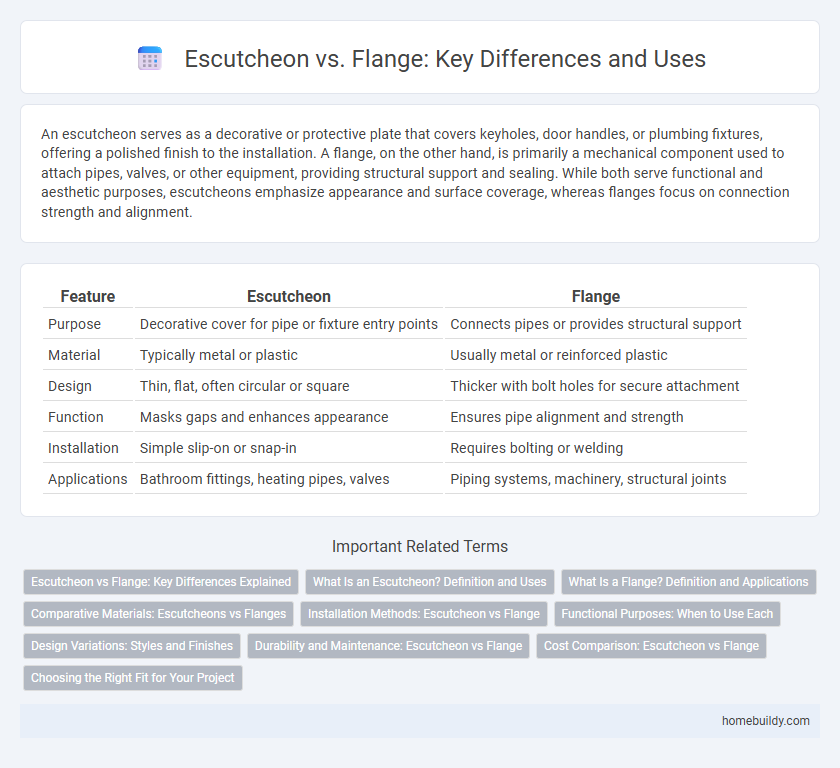An escutcheon serves as a decorative or protective plate that covers keyholes, door handles, or plumbing fixtures, offering a polished finish to the installation. A flange, on the other hand, is primarily a mechanical component used to attach pipes, valves, or other equipment, providing structural support and sealing. While both serve functional and aesthetic purposes, escutcheons emphasize appearance and surface coverage, whereas flanges focus on connection strength and alignment.
Table of Comparison
| Feature | Escutcheon | Flange |
|---|---|---|
| Purpose | Decorative cover for pipe or fixture entry points | Connects pipes or provides structural support |
| Material | Typically metal or plastic | Usually metal or reinforced plastic |
| Design | Thin, flat, often circular or square | Thicker with bolt holes for secure attachment |
| Function | Masks gaps and enhances appearance | Ensures pipe alignment and strength |
| Installation | Simple slip-on or snap-in | Requires bolting or welding |
| Applications | Bathroom fittings, heating pipes, valves | Piping systems, machinery, structural joints |
Escutcheon vs Flange: Key Differences Explained
Escutcheons and flanges both serve as protective covers around pipes or fixtures, but escutcheons primarily provide a decorative finish to conceal gaps and enhance aesthetics, while flanges offer structural support for mounting or joining pipes. Escutcheons are typically thinner, designed to fit snugly against walls or surfaces, whereas flanges are thicker and often bolted to secure pipe connections. Understanding their distinct functions in plumbing and construction helps ensure proper application and improved system integrity.
What Is an Escutcheon? Definition and Uses
An escutcheon is a protective or decorative plate typically used to cover the area around a pipe or keyhole, preventing damage and concealing gaps. Unlike a flange, which primarily serves as a mechanical connector between pipes or fittings, an escutcheon focuses on aesthetics and surface protection. Commonly found in plumbing and cabinetry, escutcheons enhance the appearance while providing a waterproof or dustproof seal around fixtures.
What Is a Flange? Definition and Applications
A flange is a mechanical component used to connect pipes, valves, pumps, and other equipment, providing a secure and leak-proof joint primarily in plumbing and industrial applications. Unlike an escutcheon, which mainly serves as a decorative and protective cover around pipe openings to conceal gaps and holes, a flange is integral to structural connections and fluid containment. Flanges often feature bolt holes and are available in various types such as slip-on, weld neck, and blind, tailored to specific pressure and temperature requirements.
Comparative Materials: Escutcheons vs Flanges
Escutcheons are typically made from polished brass, stainless steel, or chrome-plated metals designed for decorative and protective purposes, while flanges often utilize more robust materials such as cast iron, steel, or heavy-duty plastic to handle structural support and pipe connections. Escutcheons prioritize aesthetic finishes and corrosion resistance, making them ideal for interior applications where appearance matters, whereas flanges emphasize strength and durability in high-pressure or industrial plumbing systems. Material selection between escutcheons and flanges directly impacts their functional roles and suitability in residential versus commercial piping installations.
Installation Methods: Escutcheon vs Flange
Escutcheons typically install by sliding over pipes or fittings and securing with set screws or adhesive, providing a flush and decorative cover for wall openings. Flanges generally require mounting to surfaces using screws or bolts, offering a more structural connection around pipes or ducts. Installation of escutcheons is usually quicker and less invasive compared to the flange method, which often necessitates precise alignment and additional hardware for secure attachment.
Functional Purposes: When to Use Each
Escutcheons serve primarily to cover holes or gaps around pipes or fixtures, providing a neat, finished appearance while protecting surfaces from dirt and moisture. Flanges function as structural supports or connectors, often used to attach pipes to walls or floors securely, ensuring stability and alignment. Use an escutcheon when the goal is aesthetic concealment and surface protection, while a flange is essential for mechanical support and fixture attachment.
Design Variations: Styles and Finishes
Escutcheons and flanges both serve as cover plates in plumbing and hardware applications, but escutcheons typically offer more diverse design variations including styles like rosette, square, and decorative motifs, enhancing aesthetic appeal. Escutcheons come in an array of finishes such as polished chrome, brushed nickel, oil-rubbed bronze, and antique brass, allowing seamless integration with varying interior designs. Flanges usually have simpler finishes and shapes, prioritizing function over ornate design, making escutcheons the preferred choice for visible fixtures requiring style and elegance.
Durability and Maintenance: Escutcheon vs Flange
Escutcheons offer superior durability due to their solid metal construction, which resists corrosion and wear better than many flange materials typically made from plastic or softer metals. Maintenance for escutcheons is minimal since their robust design prevents damage and requires less frequent replacement compared to flanges that may crack or degrade over time. Choosing an escutcheon ensures long-lasting protection and reduced upkeep costs in plumbing and hardware installations.
Cost Comparison: Escutcheon vs Flange
Escutcheons generally have a higher initial cost compared to flanges due to their decorative design and more intricate manufacturing processes. Flanges are typically more affordable, offering a basic, functional cover without aesthetic enhancements. When budgeting for plumbing or hardware installations, choosing between an escutcheon and a flange depends on the balance between cost and desired visual appeal.
Choosing the Right Fit for Your Project
Selecting the right fit for your project involves understanding the differences between an escutcheon and a flange. An escutcheon provides a decorative cover that conceals gaps around pipes or fixtures, enhancing aesthetic appeal without compromising functionality. In contrast, a flange offers structural support and secures piping connections, making it essential for stability and durability in plumbing or mechanical installations.
escutcheon vs flange Infographic

 homebuildy.com
homebuildy.com